
 Jordan Deshane
The Hockey Writers
Jordan Deshane
The Hockey Writers
55
Reads
0
Comments
Sabres Need to Do the Opposite of Their Offseason Instincts
“Why did it all turn out like this for me? I had so much promise. I was personable, I was bright. Oh, maybe not academically speaking, but… I was perceptive. I always know when someone’s uncomfortable at a party. It became very clear to me sitting out there today, that every decision I’ve ever made, in my entire life, has been wrong. My life is the opposite of everything I want it to be. Every instinct I have, in every part of life, be it something to wear, something to eat… It’s all been wrong.”
With those words, George Costanza assessed his life and realized it wasn’t what he wanted it to be. To say the Buffalo Sabres and their fans have reached a similar point would be an understatement. Nearly everything surrounding the team – on and off the ice – for the better part of a decade has been a disaster.
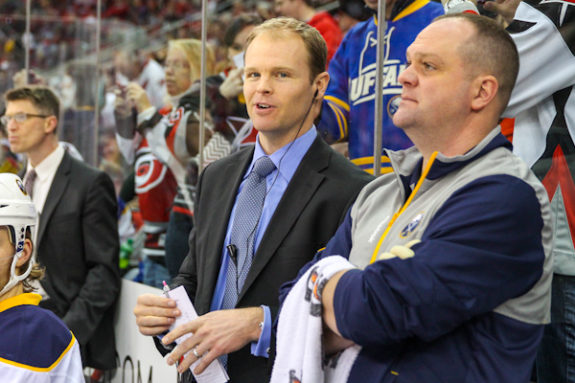
From that point on, Costanza was committed to doing the opposite of whatever his instincts told him to do. For a time, it worked. The Sabres need to adopt that same approach. They’ve already started.
Until now, the organization had never given their general manager a vote of confidence only to fire him three weeks later. They’ve now done that. During this colossal playoff drought, they have always conducted an extensive general manager search and hired one of the leading names in the industry. They didn’t do that in hiring Kevyn Adams. The Sabres have normally butchered their sweater reveals but did not with their new uniforms.
Related: The French Connection
The franchise is tracking on an opposite trajectory from the recent past. The work for this offseason is far from complete. It’s only begun. With each stage of the offseason to come, how can Adams and the organization ignore every instinct they have and instead do the opposite?
Restricted Free Agents
The organization is in a unique situation. With only 10 players under contract for next season and only five the season after, they are about as close as you can get to being an expansion franchise without having to pay the fees or name their team after a mythical sea creature.
That being said, they have nine restricted free agents this offseason and will need to re-sign Rasmus Dahlin and Henri Jokiharju next season. The decisions made this offseason will be critical to the next decade of Sabres hockey.
What would the organization’s instincts suggest they do? Normally, they would use restricted free agency to reaffirm their ideas about some players while wrongfully assessing others.
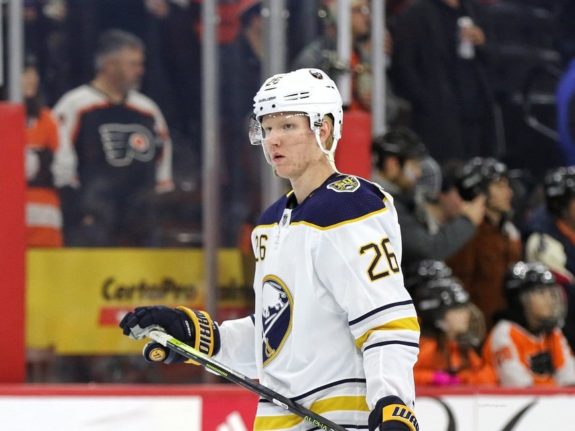
Case in point, Sam Reinhart. When his first contract came to an end in 2018, the Sabres could have signed him to a five or six-year deal at a reasonable cap hit, similar to what the Detroit Red Wings did in signing Dylan Larkin to a 5-year, $30.5 million deal. Instead, they gave him a two-year bridge contract worth $7.3 million. While they enjoyed cap savings for two seasons, they will now have to pay somewhere in the neighbourhood of $8 million to secure his services for five or more seasons according to Evolving-Hockey.
While management figures out what they’re going to do with Reinhart, Victor Olofsson is also in need of a contract. Olofsson has been on an upward trajectory since he was drafted in the seventh round in 2014. In his rookie campaign this season, he compiled 42 points in 54 games. The Sabres may be hesitant to commit to him long-term given that he has only played one season. Perhaps they believe they should also offer him a bridge deal for a couple of seasons to really see who he is before making a commitment.
As Jerry Seinfeld said to Costanza, “If every instinct you have is wrong, then the opposite would have to be right.” Now is not the time for bridge deals. Olofsson should get the extension that Reinhart should have received two years ago. Evolving-Hockey predicts he will receive a four-year deal worth just under $5 million. That’s the direction the Sabres should go. Locking up a potential premier scoring talent at a reasonable rate is something every team – but especially this one – needs to strive for.
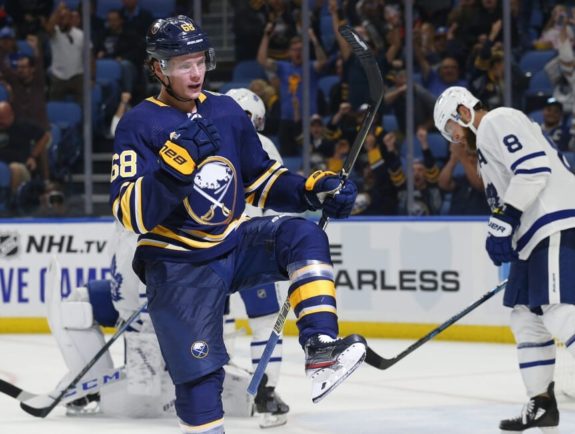
As far as other notable names go, the team doesn’t need to make as big a commitment. Dominik Kahun had a nice showing, putting up four points in six games with the Sabres, but he doesn’t need a long-term deal. Keeping him on board for a couple more seasons as a fixture of the middle-six with top-six potential would be a sound way to deal with him.
The same goes for goaltender Linus Ullmark. While he was better than Carter Hutton last season, so was nearly every other goalie in the league. There’s no need to get overly attached to him. Ullmark is an average goalie and is perfectly fine to be used in a platoon for a couple of seasons. Committing long-term to him just because he cleared the bar set by his veteran teammate would not be advisable.
The trouble comes with Brandon Montour. After trading away a first-round pick and prospect Brenden Guhle, the Sabres felt they had acquired a contributor on the right side of their defence. Montour showed well putting up 10 points in 20 games under former head coach Phil Housley. Under Ralph Krueger, however, his game has looked bleak. Montour put up just 18 points in 54 games and looked lost for long stretches.
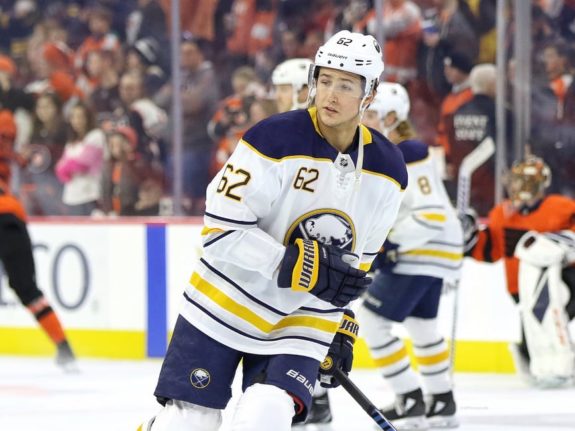
Sportsnet’s Elliotte Friedman reported that the Sabres have considered not qualifying Montour and allowing him to walk as a free agent. Adams denied the suggestion, but it’s really hard to get a read on what the plan is. His instincts could lead him in one of two ways. Perhaps he feels that the Sabres invested a lot to acquire Montour and therefore keep him so as not to appear to be giving up. On the other hand, Adams didn’t make that trade. Perhaps to show how things will be “different”, he will let him leave.
Neither inkling is correct here. No, Montour should not be part of the long-term plan. He struggles to establish and build offence in the offensive zone. He’s an excellent transitional player, but as long as Krueger disengages his defenders and deploys him in the zone in which he’s least effective, he will not be useful. Nor should the team give up on him and let him walk to prove a point.
Montour has value around the league and should be used as a trade piece to acquire more help in the forward ranks. Even if they don’t recoup what they gave up on paper, if they can find a forward who has better synergy with Krueger’s plan going forward, they will be better off doing it.
The last person of interest is Casey Mittelstadt. Having used another eighth-overall pick to select him in 2017, the team has shown a great deal of patience. He is beginning to look like a bust. At the very least, he will not be the second-line centre they were hoping for.
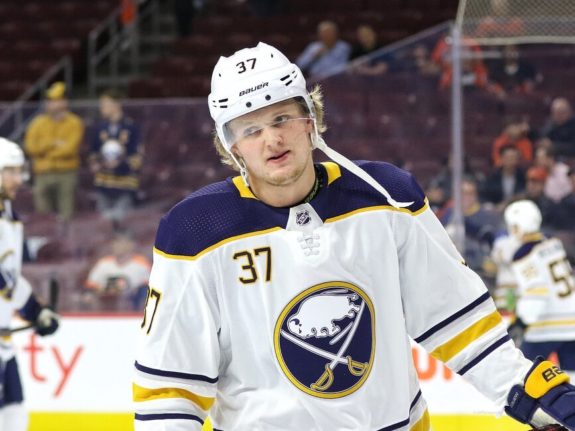
Many young players that are drafted high struggle out of the gate but eventually turn it around. The Vancouver Canucks drafted Jake Virtanen sixth overall in 2014. Six seasons later, he is finally beginning to look like a piece who could play in the top-six. Are the Sabres willing to wait until 2023 to find out whether they have their own Virtanen or if he’s a Michael Dal Colle? Who? Exactly.
If there is a team that values him and he can be added to get a greater return, he should be. The organization shouldn’t feel compelled to stand by him. They don’t owe him anything. Forget the conventional wisdom and move on before it’s too late.
Offer Sheets
Nothing is considered more taboo in NHL circles than the dreaded offer sheet. Very few general managers have used them. When they do, they are often not executed properly. The feeling is that the men in charge don’t want to hurt their fellow managers’ feelings or risk possible retaliation (grasps pearls).
In walks Adams. He’s a brand new general manager who’s never done the job in any position at any level of hockey. Surely, he would not attempt such a heinous act. Instinct says no. No other general manager in Sabres’ history has ever signed a player to one. No other manager has ever won the Cup either. Let’s do the opposite.
The Sabres do not have free reign to sign whomever they like. When they traded their third-round pick to the New York Rangers for Jimmy Vesey, they lost a critical piece of some offer sheet scenarios. Given the picks that they have, they can make offers to players in the following price range: $0 – $1,395,053 (no compensation), $2,113,717 – $4,227,437 (second-round pick) and $10,568,590 or more (four first-round picks).
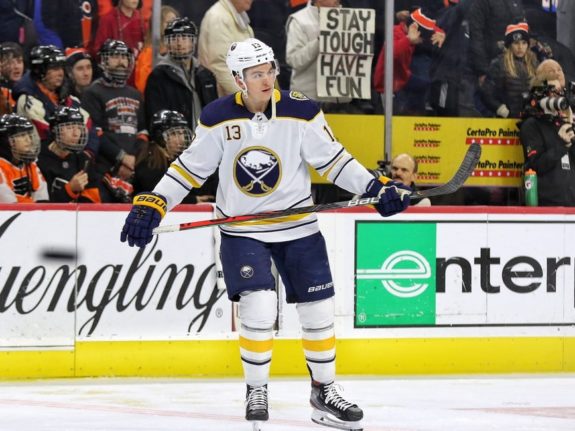
In the lower ranges, Adams shouldn’t waste his time as his cohorts will simply match the offer. With the cap likely to stay flat for the foreseeable future, every penny will count. Instead, he should target a few players who are of interest and give them a slight raise. In the best-case scenario, he gets the player he wants. In the worst-case scenario, the original team retains the player but pays $100,000 or $200,000 more than they were planning. Those figures make a difference. This is a competition after all.
The same goes for the medium-range players. There are impact players to be found in this range. Teams like the Boston Bruins, Calgary Flames, Dallas Stars and St. Louis Blues will be right up against the cap next season. Push them a little bit on Jake DeBrusk, Andrew Mangiapane, Denis Gurianov, Roope Hintz and Vince Dunn. They are all quality players with youth on their side who will only cost a second-round pick. If they all sign with their original teams, Adams can force their hand to pay an extra $1 million – something much more manageable for the Sabres to carry at this time.
Even at the highest range, there is still room to come out ahead. The compensation is calculated based on the average salary per season up to five seasons. Thus, if Adams signs a player to a seven-year deal, the compensation will be determined based on the total dollar value divided by five seasons instead of seven. Normally, this is a deterrent as teams want to sign players for longer than five seasons but don’t have the stomach to pay the picks.

If, however, the Sabres come to the conclusion that this is an avenue they want to travel down, they can save a little in average annual value. Rather than signing a player to a deal worth $10,568,590 annually for seven seasons, they can sign him to a seven-year deal at $7.55 million. Granted, most teams would match that for an elite player. The New York Islanders’ Matt Barzal may be worth targeting though.
The Islanders are projected to have just over $8 million in cap space for next season. In addition to Barzal, they will also need new deals for Ryan Pulock and Devon Toews. General manager Lou Lamoriello has stated clearly that he won’t be pushed around and he will match any offer sheet sent to Barzal. Let’s see if he’s a man of his word.
Barzal is an excellent player and would be an ideal option up the middle behind Jack Eichel. All that being true, the Sabres would still need to do some work to make all the pieces fit. Barzal is projected to receive an eight-year deal from the Islanders with an average salary of $9,581,000. That’s rich, but the Sabres could still do some damage to it.
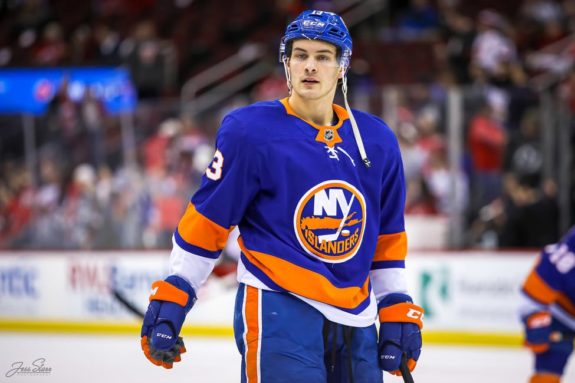
The Sabres could offer a seven-year deal worth $10 million per season. Offering more could make things awkward with the franchise’s cornerstone Eichel. This deal could be more attractive to Barzal as it would give him a higher salary and make him an unrestricted free agent a year earlier. The Islanders would likely match it as the increase wouldn’t be insurmountable, but losing a year of control would be frustrating.
Maybe you’re wondering what these moves accomplish. If each player is matched by their team, the effect will be minimal, besides the fact that Adams is making life a little more difficult for their competition. If the Sabres could add one of these players, though, it would send a message to the rest of the league. The Sabres are here. They want to win. They’re tired of losing to (literally) all of you.
An offer sheet has never been extended in the 50-year history of the franchise. The team has never missed the playoffs for nine straight seasons until now. It’s time to shake things up and do things a little differently.
Unrestricted Free Agency
As we said earlier, the Sabres are as close as you can get to having a clean slate salary-wise. They are projected to have nearly $35 million in cap space. A new general manager coming to a team on an unprecedented losing streak may feel compelled to be bold in free agency. While we are calling for aggression in some areas, this is one aspect of the offseason where Adams needs to take a backseat.
While they have flexibility, that will quickly evaporate. If they signed each restricted free agent to their projected contract, they would have around $11 million in space and still have to sign Dahlin and Jokiharju to new contracts after next season. There are holes to fill on the roster with at least two potential openings in the top-six as well as on the left side on defence and in net.
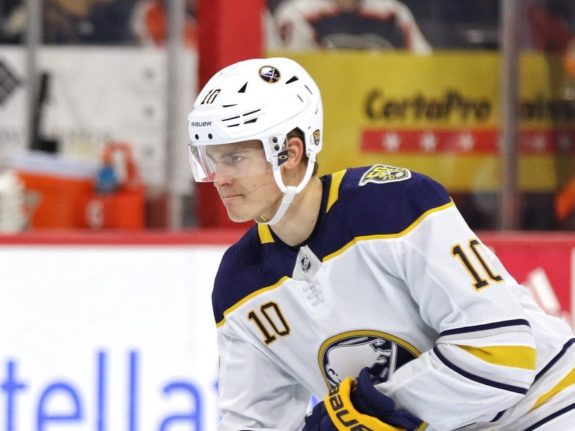
To load up on a player approaching his thirties is a bad move for this team at this time. Catching the big free-agent fish is not something they should do this season. If the team was a little more competitive or perhaps designed without so many restricted free agents coming up at the same time, they could be in a position to add an impact player.
Adams needs to do the opposite of what most rookie general managers’ instincts would suggest. Free agency can be a tool, but he must use it to effectively add depth pieces that will help them win more than they lose. Craig Smith, Kyle Clifford or even a one-year deal for Alex Galchenyuk could make sense for the Sabres without breaking the bank.
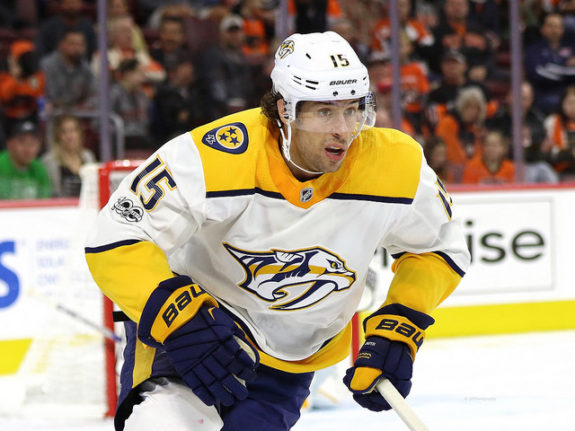
When it comes to their own unrestricted free agents, the Sabres have seven on the NHL roster. Conventional wisdom would dictate that there must be some value there and they should try to retain some of them. In reality, outside of Johan Larsson, there is not much value to be found in these ranks. If Larsson is interested in coming back, the team should have that conversation and find a way to make it work. If he’s not interested, can you really blame him?
In any event, unrestricted free agency should be a fairly boring time for Sabres fans. At the very least, they should hope it is.
The Draft and Trading
We finally get to the part that new general managers are the most excited for. Where they can really put their stamp on the franchise is through trades and a high draft pick. Although not his first pick or trade, former general manager Tim Murray did that when he acquired Robin Lehner and Ryan O’Reilly just hours before drafting Eichel. In his second offseason, Jason Botterill was able to draft Rasmus Dahlin and trade for Jeff Skinner.
As Adams examines his assets, no doubt he is excited to use them. He should look at Rasmus Ristolainen and Montour as his two big trade chips. With the eighth-overall pick, he is also undoubtedly excited to draft high in what is widely considered a very strong draft. If these are his instincts, is he right?
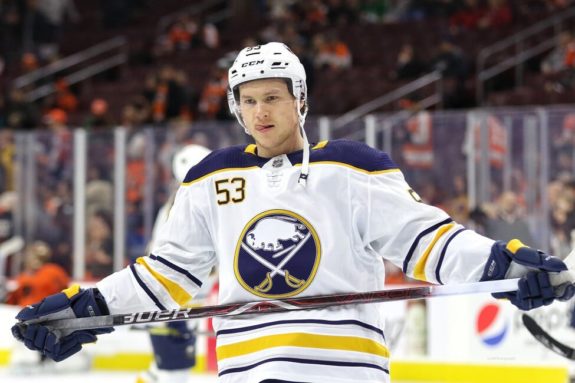
The high pick should absolutely be in play this offseason. The Sabres will pick in the top-eight for the eighth straight year, and what have they earned in that time? More top-eight picks. The time of drafting and developing has gone on too long. Now is the time to do what Murray did all those years ago, and go for it.
Related: How Sabres’ Legend Taro Tsujimoto Came to Be
With the salary cap remaining flat and teams being desperate, this is a unique time to identify targets and bring them in. Relying on getting top-six help by trading Ristolainen or Montour is not realistic at this point. Their value is too low and they will not bring the franchise what they would have one, two or three seasons ago. Packaging them along with the eighth-overall pick could be enough to get the Sabres the top-six centre they so desperately need.
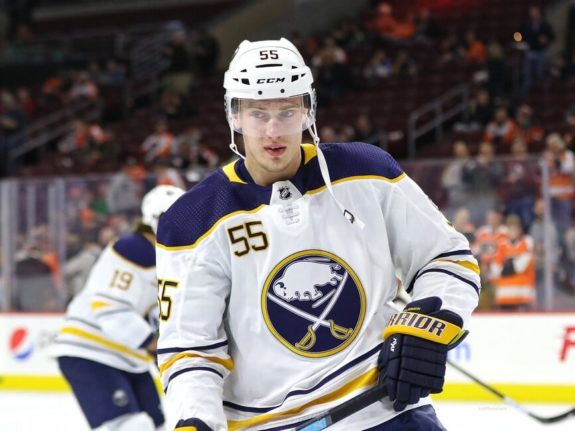
The Tampa Bay Lightning have just over $5 million to sign Anthony Cirelli, Carter Verhaeghe, Mitchell Stephens, Mikhail Segachev and Erik Cernak. Most of their high-salary players have some kind of trade protection in their contract, making it very difficult to make space. Would they consider trading Cirelli for the eighth-overall pick? It may seem like a pipe dream but that move would bolster the Lightning’s pipeline and allow them to trade a third-round pick for a top-10. It would be worth exploring.
The Toronto Maple Leafs will have about $4.5 million in cap space with numerous holes to fill, especially on the back end. Could some combination of a defender and the eighth pick be enough to pry William Nylander from them? Could Montour go to the Maple Leafs in exchange for Alex Kerfoot, adding to the Maple Leafs’ depth on defence and bringing the Sabres the desperately needed second-line centre? Although these two teams rarely trade with each other, they would make good partners this offseason.
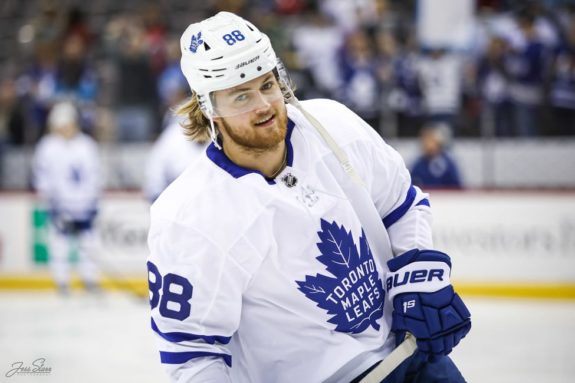
The Calgary Flames will be an interesting team to watch this offseason. They will have just under $17 million in cap space but have only nine forwards, three defencemen and one goalie under contract. The core that they have has not had success, and tensions are likely beginning to rise. Could the eighth-overall pick and Ristolainen be enough to pry Sean Monahan or Johnny Gaudreau away from the Flames? It would be a bold move, but it would give the Sabres a solution for their second line.
There are many avenues worth exploring and the options for trades will be abundant. The easy move is to keep the draft pick and make a lesser trade. That approach has yet to bring results. Will the pick eventually turn into a good NHLer? The odds are that it will. However, it may take some time and that may not be something the Sabres have a lot of. The time is now to push the team along the development path.
A Fast-Paced Offseason Ahead
Much like the NHL’s Return to Play, the offseason will come fast and furious. With the draft, free agency and training camps all being crammed into a few short weeks, the general managers who enter with a plan and execute it properly will have a major advantage. Adams and whoever else is left in the front office have nothing to do right now but plan what their October will look like.
The Sabres need their Costanza moment of self-realization. “My name is George. I’m unemployed and I live with my parents.” The team is about as sad as any team has ever been in the history of the league. What they’ve been doing isn’t working. They need to do the opposite.
Costanza was far from being a model citizen. He is not someone most will aim to be like, and most of the things he did never worked out. Yet, at this stage of the Sabres’ existence, here we are. They have already done a few things differently than they’ve tried before. Hopefully, it will work.
The post Sabres Need to Do the Opposite of Their Offseason Instincts appeared first on The Hockey Writers.
Popular Articles

















































 Blackhawks Chicago
Blackhawks Chicago Panthers Florida
Panthers Florida Penguins Pittsburgh
Penguins Pittsburgh Rangers New York
Rangers New York Avalanche Colorado
Avalanche Colorado Kings Los Angeles
Kings Los Angeles Maple Leafs Toronto
Maple Leafs Toronto Bruins Boston
Bruins Boston Capitals Washington
Capitals Washington Flames Calgary
Flames Calgary Oilers Edmonton
Oilers Edmonton Golden Knights Vegas
Golden Knights Vegas Senators Ottawa
Senators Ottawa Lightning Tampa Bay
Lightning Tampa Bay Flyers Philadelphia
Flyers Philadelphia Islanders New York
Islanders New York Sabres Buffalo
Sabres Buffalo Red Wings Detroit
Red Wings Detroit Devils New Jersey
Devils New Jersey Hurricanes Carolina
Hurricanes Carolina Blue Jackets Columbus
Blue Jackets Columbus Predators Nashville
Predators Nashville Wild Minnesota
Wild Minnesota Blues St. Louis
Blues St. Louis Stars Dallas
Stars Dallas Jets Winnipeg
Jets Winnipeg Mammoth Utah
Mammoth Utah Sharks San Jose
Sharks San Jose Canucks Vancouver
Canucks Vancouver Ducks Anaheim
Ducks Anaheim






